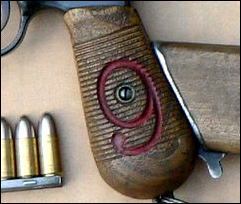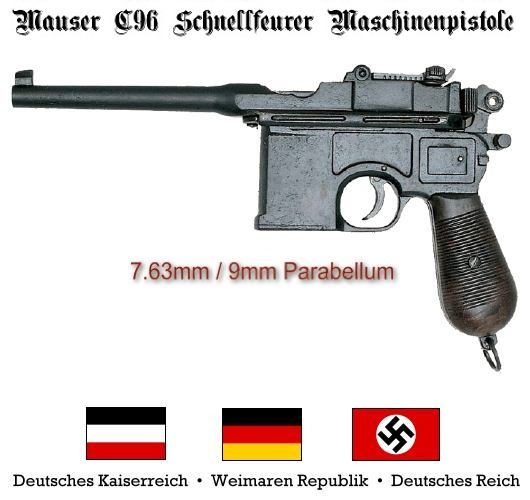Mauser C96 Machine Pistol. Worlds first and most recognizable small arm, the famous "Schnellfeurer Maschinenpistole"

The Germans have often led the way in
engineering and development, especially in firearms. The
story of the world's first machine
pistol, the Mauser Construktion 96 was the opening act on innovative
firearms developement, and set the stage for what would later come to
be known as "submachine guns." The lines are sometimes
blurred between machine pistol and submachine gun, and can even fuel a
debate. For now, let's stick to the basic history of
the now-legendary Mauser C96, and you can decide the category to which
it should be assigned. The story of the C96 is a complicated
one. If ever there was a modern firearm whose time, place and
date of manufacture is difficult to trace, this is the
one. While there are many other
makes and models of modern firearms with identity crises over serial
numbers, the C96 surely takes the prize in this category! It
may even surpass the difficulty identifying some of the early Smith and
Wesson .357 Magnums, which for a time had NO serial numbers.
In keeping with human inclination
to be averse to change and
suspicious of new ideas, the C96 was not as well-received as its
makers hoped when it was first introduced. To give the
impression that they had sold more units than were actually
sold, they skipped large blocks of serial numbers--not an unheard-of
marketing strategy. Later, when production picked up, they
appear to have raided their own stock of parts from previous production
runs
and retroactively stamped firearms with older serial numbers to fill in
the gaps. Along with the confusion caused by various
modifications to the original model, there was the inevitable
switching out of parts by owners further down the line.
Finally, there were the Chinese-made copies that were almost totally
undocumented, along with some made in Spain. The
result is a researcher's or collector's nightmare!
But despite the confusion, this much is true: the C96 was the first
maschinenpistole/submachine gun ever made, and since it was a major
innovation for its time and went on to enjoy considerable
success, it has earned its place in history, despite the clouded
provenance.

Like other truly classic German guns, the C96 is unique and instantly recognizable. If not easily identified by its signature "broomhanlde" grip, it also had an integrated box magazine just forward of the trigger. Even with its many variations, as soon you lay eyes on a Mauser C96, you'll immediately know what it is, even if you may never track down its exact history.
Originally, the Mauser C96 was produced for a 7.63 X 25mm cartridge. There was also a 9mm Parabellum produced, which proved successful. The 9mm Mausers were named the "Red 9" and had a large red "9" marked on the grips, to differentiate them from the 7.63mm version, in order to prevent the confusion of ammunition sizes. Later, many of the original 7.63 models had the barrels bored out to accept 9mm Parabellum cartridges. This was necessary because the C96 had a single one-piece casting for the barrel and receiver, so replacing a worn-out barrel was not an option. You'd basically have to replace the whole gun. Unfortunately for collectors and researchers, some of those 7.63mm-cum-9mm conversions were also branded with the big red "9", adding more confusion to the equation. The original model C96 came with a detachable stock that also doubled as a holster--a clever innovation that DWM, the makers of the famed Luger P08 Parabellum--could'nt resist offering as an option to its own successful pistol. The 7.63mm rounds used by the C96 offered good velocity and penetration, adding to its success.
Along with the original models designed by the Feederle brothers-- Fidel, Friedrich and Josef--and manufactured by Mauser, there were also two Spanish companies, Beistegui Hermanos, and Astra that Produced a selective-fire version of the C96. Mauser also produced their own selective-fire version, the M712 Schnellfeurer. (German for "Rapid Fire") The Chinese Taiyuan Arsenal even produced a .45 ACP model, to accept ammunition they already had in stock for another firearm they were using, a knockoff of the American Thompson submachine gun.
In the years before the Great War, (aka World War I) the Mauser C96 and its many variations became very popular, and orders came in from military forces in a number of nations. This allowed the C96 to find its way around the globe. They were popular with British officers, Red Bolshevik revolutionaries and Chinese militants in the various skirmishes that plagued China throughout the 20th century. The C96 went on to see action in various wars and revolutions worldwide, and even saw limited use by Germans and others in World War II. As a trivial sidenote, the "blaster" used by Han Solo in Star Wars was based on the Mauser C96. The American National Firearms Act of 1934 precluded most Mauser C96 firearms fro m finding their way past US shores. Even now, there are estimated to be fewer than 200 of them in circulation in the United States, even tho u gh Mauser alone produced over a million of them. By today's standards, the C96 is an antique and a collectors' item, and owing to their scarcity in the US, can bring very high prices at auction.
Firearm Type: Machine
Pistol / Semi-Automatic
Nation Of Manufacture: German Empire,
Weimar Republic, Spain, China
Military Service Dates : 1899-1961
Variations: C96, Selective-Fire M712
Schenllfeuer, Bolo, others
Ammunition: 7.63mm, 9mm Parabellum
Wars: WW1, WW2, Spanish Civil War, Chinese
Civil War, Many others
Recent Prices at Auction for Originals: US
$750-$4,000+
Interested in an authentic replica of a Mauser C96 "Broom Handle" Machine Pistol?